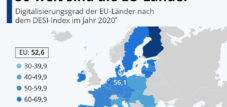Providers are required to install 1,000 5G base stations by 2022. At the same time, the Federal Network Agency mandates that these be distributed proportionally across the federal states. The strategy consultancy LSP Digital has now calculated, using a model, how far this obligation will actually go. The result: the coverage requirements will only reach a fraction of households in a given federal state (from 0.4 percent in Berlin to a maximum of ten percent in Bavaria). Particularly in the city-states, it can be assumed that the actual number of 5G base stations will be significantly higher. But even across the board, the rollout will likely proceed faster than the requirement suggests. Deutsche Telekom alone has announced its intention to provide 5G coverage to 99 percent of households by the end of 2025.
Basic assumptions of the model calculation
– 5G license allocation from Telekom, Vodafone and O2
– The mandatory number of base stations will be set up in the population centers (largest cities per federal state)
– LSP estimate is based on the number of households/km² per city, the radio range of a 5G antenna, the average household size per federal state and the expected provider overlap in the cities
The providers have to install 1,000 5G base stations by 2022. At the same time, the Federal Network Agency obliges the mobile phone providers to distribute these proportionally across the federal states. The strategy consultancy LSP Digital has now calculated in a model calculation how far this obligation actually carries. Result: With the coverage requirements, only a fraction of the households in a federal state will be reached (from 0.4 percent in Berlin to a maximum of ten percent in Bavaria). In the city states in particular, it can be assumed that the actual number of 5G base stations will be significantly higher. However, the expansion will also probably proceed faster in terms of breadth than the condition would suggest. Only Deutsche Telekom has announced that it will supply 99 percent of households with 5G by the end of 2025.
Basic assumptions of the model calculation
– 5G license allocation from Telekom, Vodafone and O2
– The mandatory number of base stations is set up in the population centers (largest cities in each federal state)
– LSP estimate based on number of households/km2 per city, radio range of 5G antenna, average household size per province and expected overlap in cities


